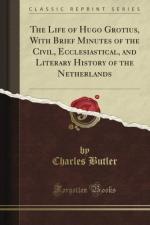[Footnote 006: It is entitled, “Martiani Minei Felicis Capellae Carthaginiensis, Viri Procunsularis, Satyricon, in quo de Nuptiis Philologiae et Mecurii libri duo, & de septem artibus liberalibus libri singulares. Omnes, et emendati et Notis sive Februis Hug. Grotii illustrati. Ex Officina Plantiniana, Apud Christophorum Raphelingium Academiae Lugduno-Bat. Typographum M. D. C.” [Transcriber’s note: Apostrophic date 1600] The Dedication to the Prince of Conde follows: then, Encomiastic Verses by Scaliger, and Tiliabrogus. The two works are then inserted, with an address to the reader, Errata, and Various Readings. Afterwards, Hugeiani Grotii Februa[007] in Satyricon Martiani Capellae: this contains his notes. They are preceded by an Engraving of Grotius. Round it, is written, “Anno M. D. C.” [Transcriber’s note: Apostrophic date 1600] Hora Ruit.[008] AEt.xv. Under the engraving the following verses are printed,
“Quem
sibi quindenis ASTRAEA sacravit ab annis,
Talis,
HUGEIANI GROTII ora fero.”]
[Footnote 007: “Corrections”—or more literarily, “Purifications".]
[Footnote 008: These words were used by Grotius for his motto.]
[Footnote 009: Fabricii Bibliotheca Latina, Lib iii. c. 15. In 1794, John Adam Goez published the “Treatise on the Marriage of Philology and Mercury” separately, in a duodecimo volume: he mentions, in the preface, an edition of it by Walthard. It is on the authority of Goez that we have assigned the age of Capella to the third century: others place him in a much later period.]
[Footnote 010: Montucla. Histoire des Mathematiques, Vol.ii. p.657.]
[Footnote 011: Vol. 9. p. 147. ii. 1.]
[Footnote 012: A similar exclusive claim in respect to the Indian seas, under the grant of Pope Alexander VI., was set up by the Portuguese; similar claims to the Ligustic and Adriatic seas, have been and still continue to be made by the Genoese and Venetians. Those, who seek for information on the subject, should consult the Dissertation of Bynkershook de Dominio Maris, and note 61 to the recent edition of Sir Edward Coke’s Commentary upon Littleton.]
[Footnote 013: “Mais, dites vous, dans ce tems meme, le jeune Pison pouvolt avoir dix ans: Grotius faisoit bien des vers a cet age. Je le scais, mais les Grotius sont ils bien commune! combien d’enfans trouveres vous de dix ans, qui ayent nonseulement assez du feu pour faire des vers, mais encore assez de jugement pour en juger sainement.” Gibbon’s Posthumous Works, 8vo. vol. i. p. 520.—“Salmasius,” says Mr. Gibbon in another part of the same entertaining publication, (vol. v. p. 209), “had read as much as Grotius; but their different modes of reading had made the one an enlighten’d philosopher; and the other, to speak plainly, a pedant puffed up with an useless erudition.”]
[Footnote 014: Bentivoglio, Histoire des Guerres de Flandres, l, xxviii.]




